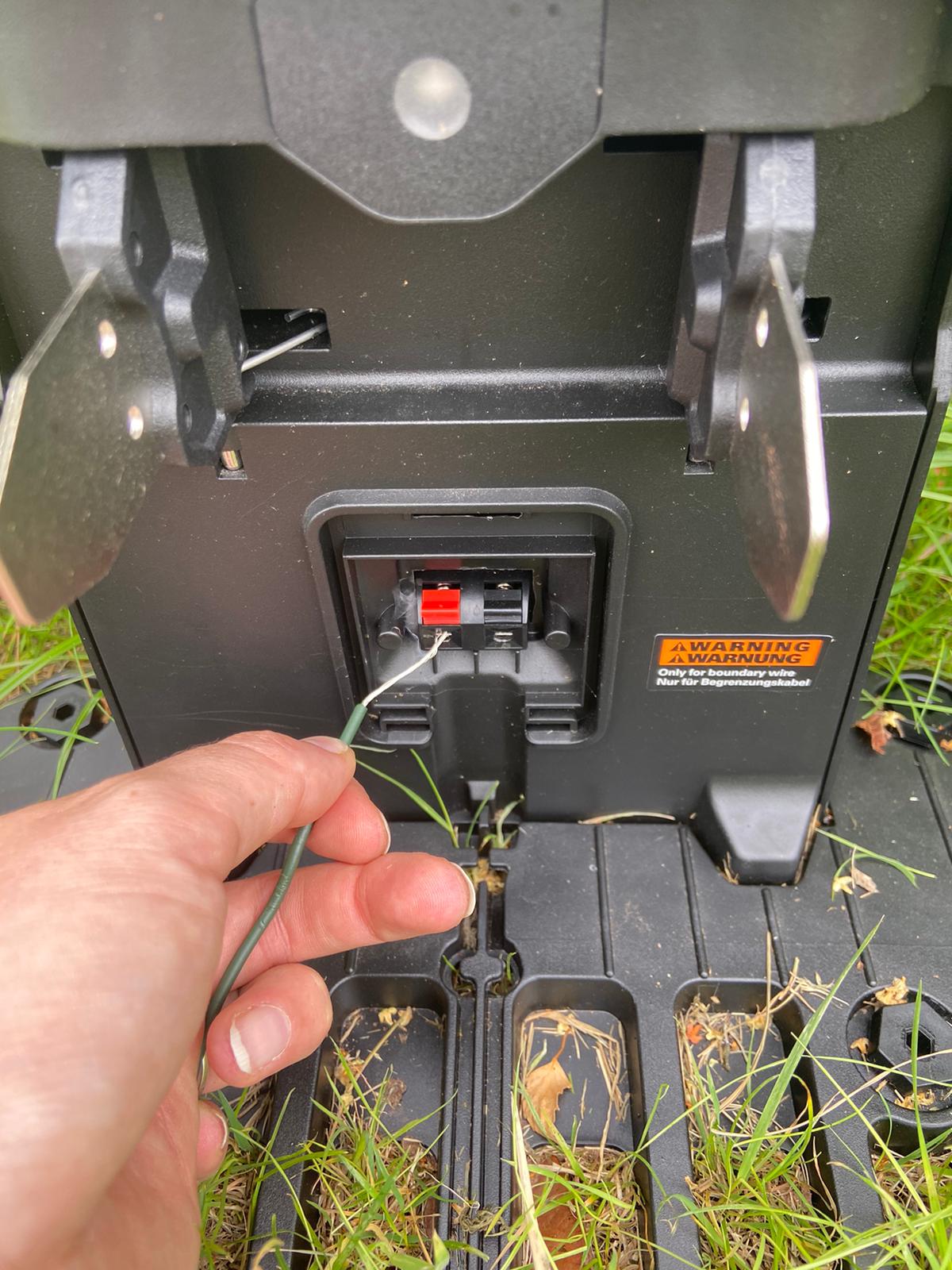The Worx Landroid M500 robot lawn mower might be for you, if you have a large lawn and not enough time to maintain it as regularly as you’d like. And, if you have been considering a robot lawn mower for some time, but baffled by the number on the market, then listen up because this may help you decide where to splash your cash.
With the ability to control the mower from an easy-to-use app and the option to schedule how regularly you want to mow the lawn, there is no need for the bulky, corded mower, taking up space in your shed. Working full-time (currently from home), with a toddler and another baby on the way in September, mowing the lawn had become somewhat of an afterthought. So, a machine that did it for me has been a welcome addition to the garden. Plus, it makes the views from my office window a lot nicer!
This is the first robot lawn mower I’ve tested, so here is the lowdown on how easy it is to set up and use, how effective it is on a multi-level garden and whether the result and convenience are worth the price. Read on to find if a robot lawn mower holds its own agains the best lawn mowers, and whether the Worx Landroid M500 is the one for you.
Worx Landroid M500 (WR141E) specification
- Power type: battery (uses one 20V rechargeable lithium ion2.0Ah battery)
- Battery length: 60mins
- Charge time: 90mins
- Cutting width: 18cm
- Cutting height: 30–60mm (with cutting grades in 10mm increments)
- Size: 55.8 x 40.4 x 20.5 cm
- Weight: 9kg
- Lawn size: Up to 500m2
- Operating system: Free Landroid smartphone app, compatible with Android or Apple
- Safety features: Obstacle detection, lift and tilt sensors, alarm function, pin code security
Who will the Worx Landroid M500 robot lawn mower suit?
Those with lawns up to 500m2 who may not have the time to mow it regularly, or who are physically unable to keep on top of their lawn maintenance.
First impressions
We unboxed the mower and found the body of the mower itself to be sturdy and of good quality. It looks fairly robust and you will either love the bright orange body that makes it easy to spot the mower when it is out and about, or you will find it a bit garish for something that will be permanently out in your garden. It also comes with a base (where it goes to charge) and the perimeter wire that sets the mowable area.
The Worx Landroid M500 comes with a lot of paper – five booklets, plus another one for the anti-collision system sensor. So, with so many manuals, and instructions, you’d expect it to be fairly easy to set up – which unfortunately we found wasn’t the case (more on this later).
Set up and installation
As I am in my last trimester of pregnancy, my partner helped me set the mower up and lay the boundary wire for the first time, (unfortunately not the only time – more on this to come). There is an owner’s manual, installation manual and a 'Get started' guide, so we started with the latter, which is just a series of pictures.
In my opinion, there is no need for the get started guide as it just mimics the installation manual which is easier to follow, and the simplified picture guide leaves you missing lots of vital information. I also wish the instructions told you to install the app as one of the first steps, as they have a full installation guide on the ‘support’ section, which I found very helpful for troubleshooting, following initial installation.
Top tips for successful installation
1. Download the app to guide your through the process first.
2. Mow your lawn beforehand.
3. Make sure the boundary wire is taut and flat to the ground. You can even lay it into an indent to be sure.
Setting up the boundary wire
Both the app and the paper instructions preach that planning is key and it will help avoid timely mistakes. This advice should be taken as gospel, which I found out a couple of hours later. Some of the most important points are that the boundary wire should lay flat to the surface of the lawn, the charging station should be in a completely suitable place and a full inspection should be done of the lawn to identify any obstacles.
There is one more point listed at the start of the installation guide, which I think should be listed as mandatory and repeated, as I found it was key to a successful set up. This was point ‘1.8’ – mow the grass if it is longer than 10cm and if you want to shorten the height of the grass, do this progressively by adjusting the cutting height in steps. On the first set up, we missed this point, so left the cutting height at 40mm and didn’t mow the grass to start with, as it has been done about two weeks previously.
Firstly, we set up the charging base, which needs to be on flat land, in shade, and within reach of the AC mains. It also needs a straight path in and out of the station, with a certain amount of space either side. Similarly, the boundary wire has to be placed a certain distance from steps, edges and pools, plus you have to think about how steep slopes are.

To lay the boundary wire and connect it to the charging station, I was sent back to my school electronics lessons, stripping the end of the wire with some scissors, then connecting it to the clamp in the station base. You then set up a circuit round the perimeter of your lawn, placing ground pegs at 80cm intervals. It is important to lay extra pegs where the ground undulates, ensuring the wire is in close contact with the ground at all points. This is also key to a successful set up – something my partner didn’t pay close enough attention to during the initial set up.
Our lawn is over three levels, with steps down one side, but there is a slope on the opposite side which the mower could access to reach all areas of grass. There is a handy ruler in the box to help set the wire the right distance from steps and edges.

Setup certainly wasn't child's play as my partner learnt when he had to relay the wire due to it not being taut enough first time round
Getting going
Once you have laid the wire, you return back to the charging base and repeat the process of stripping the wire and feeding the end into the other clamp. Next, you connect the station to the AC mains socket and if everything is fine, a green LED shows on the base. If there’s any problems with the circuit, a dreaded red LED will show. Luckily, our LED shone green and we moved on to setting up the mower itself.
Inserting the battery is easy enough but fitting the anti-collision system sensor was a bit more difficult, as I struggled to prise the cover off with a screwdriver, as the pictured instructions in the ‘ACS get started’ guide showed. My partner managed to remove the cover eventually, then you connect the sensor to the relevant components and then screw it into position using an allen key.
Next the mower has to be left to charge, so you simply place it on the base. Whilst the mower was charging, I downloaded the Landroid app from the Apple store and connected the mower to the Wi-Fi, following instructions on the app. This was very easy, as all you have to do is register your account, either by entering in details or logging in through Facebook or Google, then input the model’s serial number using the QR code found under the rear bonnet of the machine. You then select your Wi-Fi network, ensuring the landroid is in the same router environment as your smartphone. You can purchase a Landroid Radio Link if you find your Wi-Fi doesn’t cover your entire lawn.
How easy is it to use the Worx Landroid M500 robot lawn mower?
Once you have given the Landroid a bit of time to charge, you can either send it on its way either from the app, or by using the control panel on the top of the machine. On the ‘home’ option of the app, all you need to do is press the play button and like magic, the Landroid M500 starts and informs you that it is ‘mowing’.
We moved into our house in February this year and I’m ashamed to say, that before then, I had never mowed a lawn before! Our previous house had no grass, so I quite enjoyed mowing our new lawn in neat lines on the few occasions, before the arrival of the robot mower.
I’m afraid that if you enjoy the aesthetics of beautifully straight lines in your lawn, you will be disappointed by the Landroid’s operation as its movements appear a bit sporadic. It sets off straight, but then as it hits the boundary wire, it then turns at an angle and continues mowing in a straight line, until it hits the boundary wire again. It then continues in this fashion until it gets close to running out of battery or believes it has covered all of your lawn.
For its first run, it was going well until it ran into a few problems near the edges of the middle level, where the border wall, meets the grass. The wheels seemed to be getting stuck in between, where there is a slight dip, so we had to bring the boundary wire in slightly to fix this and restart the mower. When the mower gets stuck, it displays an error message on the app and you have to restart it from the mower itself, rather than from the app.
The first run wasn’t a complete success, as it had missed areas of the lawn and it became clear that the ‘cut to edge’ feature couldn’t be used in all areas, as it was on uneven ground, causing the wheels to get stuck. We used the mower again the next day and that’s when we started to run into problems. Within minutes of setting the mower off, I got an error message saying the boundary wire was missing. Upon inspection, the mower had cut straight through the lower boundary wire, so we were forced to use the waterproof boundary wire connectors. The mower comes with two of these and it’s easy enough to fix, although the written installation guide advises using one connector, whereas the app advises using two.
We used one on the first break, which was lucky as the next time we used the mower, the same thing happened again, but in a different place. We had a few more successful runs, but then on the third break, I decided to relay the wire on just the lower level and largest part of the lawn.
I reread the instructions and mowed the lawn before installing the wire again – steps my other half had not done thoroughly enough to give the Landroid the best chance. I also ensured that the boundary wire was flat to the ground in every dip, by placing extra pegs where needed. After speaking to my brother-in-law, who has a Flymo robotic lawnmower, he also suggested starting the mower on the highest cut, as Flymo recommend in their instructions. The mower has now been running successfully for two weeks, with no further issues.
Cutting results
The Worx Landroid M500 boasts that you no longer will have grass clippings to collect. This is because with a regular mowing schedule, it produces very short clippings that don’t need to be raked and lie on top of the lawn, providing the ‘perfect organic nutrient’. It also claims that frequent mowing boosts the density of grass blades and prevents the propagation of weeds.
Our lawn certainly looks very healthy, even during the recent hot spell. The edges and borders need tidying up, as there is a fence at the bottom of the garden and the mower cannot cut around the posts effectively. There is also a dip into the flower beds, so although the mower gets as close to the edges as it can, some trimming with a strimmer or shears is needed.
The other impressive thing to note is how quiet the machine is. Our home office is located in the garden and I don’t realise the mower is going, until I either spot it through the window out of the corner of my eye, or it tries to mow over a rogue stick.

This was the garden prior to set up. As you can see the grass is patchy in places (it now looks well restored) and there is a slope with some terracing higher up
What features and settings does it have?
Some of the technological features of this mower really set it apart from its competitors. It is an IoT (Internet of Things) device, meaning it uses artificial intelligence to get the best results for your lawn.
Make sure you keep the app updated, as the latest update has some incredible features, including a cute 'Save the hedgehogs' mode, which prevents the mower from operating during the evenings, when hedgehogs might be roaming your lawn.
You can auto schedule the mower and enter in details about the lawn size, just by walking the border. The app can also monitor features such as soil type, grass species and irrigation. Alongside its handy rain sensors and rain delay feature, the mower then outputs a mowing schedule, which you can adapt to set times and days where the mower is not allowed to work, for instance times when kids might be out playing, or even by using ‘party mode’ where the mower suspends its schedule until you disable it, so you can enjoy your BBQ in peace. They have certainly thought about how this mower fits around you rather than the other way round.
You can also set the Landroid to mow just the border a couple of times a week, set up ‘multi-zone’ so your mower spends a defined amount of time in different zones of your lawn and prevent unauthorised people from using your mower by setting up pin code protection. There is the option to operate the mower using voice control and if you’re worried about your mower being stolen, there is the ‘Find My Landroid’ option on the app, where you can remotely lock and track it.
Finally, you can name your mower – ours is now affectionally called ‘Derek’.
How does the Worx Landroid M500 rate online?
With glowing reviews from a number of websites, users agree that this mower is easy to use once set up properly, saves a lot of time, with great results.
Some users have experienced the same teething issues as I did, with the machine cutting the boundary wire, or having issues with the mower getting stuck on uneven ground. But all agreed – with a few adjustments to the boundary wire and by using the repair kit – the mower works very well, once set up properly.
Most reviewers rewarded it 4 to 5 stars.
How does it compare to other robot lawn mowers?
This is the first robot lawn mower I have used and can only compare it to what I have seen of my brother-in-law’s Flymo, which also rates very highly online and is cheaper. There are a couple of smaller models from Worx that cost less, but this is the best choice for large gardens and worth the investment as it will cover your full lawn in one go.
Although I agree with some users that the installation was timely, it seems as if most robot lawn mowers have the same issue, with some taking up to a day to install. The Worx Landroid, certainly does not take this much time to set up and the app helps with troubleshooting, which is where some other mowers get marked down.
The verdict
If you have a fairly uncomplex lawn and are looking to keep your lawn well maintained, whilst saving time, I would definitely recommend this mower. It takes a lot of patience to set up and tested me on the third occasion of cutting its own wire, but once I had rectified the problems, mainly caused from the original installation (if you want something done right, do it yourself...), I am very happy with the results.
It now saves time on regular mowing, and means the grass can be mowed as often as it needs for optimum results. Yes, I miss the stripes, but the grass is looking healthier from more frequent trims.
About our reviews – and our reviewer
We test all appliances in the setting in which they were intended to be used – a home setting. This robot lawn mower was tested by Bethan Davis, a PR and events officer, who is currently working from home juggling her career, a full-on toddler, two even more needy cats, and pregnancy. With a lot going on – and weather that seems to have made our lawns flourish after every cut – she needed a good time saver to keep the garden trim.
Read more:
Join our newsletter
Get small space home decor ideas, celeb inspiration, DIY tips and more, straight to your inbox!
Bethan works in PR in the tourism industry and lives with her fiancé, toddler Danny (with another baby on the way) and two cats, Jasper and Leo. She is always looking for appliances and tools that will make busy family life easier (and less messy) so she can cut the time she spends cooking, cleaning and washing when she gets home. She strives to find the perfect stylish storage solution for her son's toy dinosaur collection and is currently decorating her new home, room by room.
-
 Jennifer Garner's dining room is filled with “cohesive and intentional” features that showcase her personality
Jennifer Garner's dining room is filled with “cohesive and intentional” features that showcase her personalityDesigners love how the actor's space is rustic yet refined
By Eve Smallman Published
-
 Bobby Berk has revealed his favorite wall paint color — designers agree that it's a chic choice
Bobby Berk has revealed his favorite wall paint color — designers agree that it's a chic choiceThe Queer Eye star's choice of black is elegant and easy to decorate with
By Eve Smallman Published
-
 Vanessa Hudgens’ wallpaper puts a trendy twist on a classic style — designers love her effortless approach
Vanessa Hudgens’ wallpaper puts a trendy twist on a classic style — designers love her effortless approachThe actor's nature-inspired print is characterful and chic
By Eve Smallman Published
